The Astro Slide is the very definition of a niche device, providing a uniquely accomplished full qwerty typing experience that you simply won’t find elsewhere. It’s lacking in almost every other way, however, and it isn’t as cheap as its components suggest, so only those who genuinely want that ‘pocket laptop’ experience need apply.
Pros
- Unique Qwerty typing
- Wireless charging
- Two USB-C ports
Cons
- Very big and heavy
- Screen very unbalanced
- Performance poor for the price
-
It’s differentA unique experience from a modern phone thanks to the keyboard -
StorageDecent amounts of internal storage -
Physical keyboardQWERTY Keyboard slides out from under the phone
Introduction
It might sound like a water park attraction, but the Astro Slide is actually a crowd-funded smartphone from Planet Computers, with much of the team behind the beloved Psion series working on its quirky PDA form factor.
For those unfamiliar with the wild pre-smartphone days, the key feature here is a full mechanical keyboard stashed behind a full-sized display. Crank that screen up and into position, and you effectively have a teeny tiny Android-powered laptop.
It’s something a lot of people used to pine for in the early smartphone days, and which a dedicated minority continue to desire – hence the Astro Slide’s crowdfunding success.
So does this jumble of old and new features cohere into a complete and satisfying device? Is it worth the £729 asking price? And who’s actually going to want to own such a phone? Let’s take a closer look.
Design and screen
- Thick and heavy body
- Somewhat creaky slider mechanism
- Unbalanced 60Hz AMOLED display
However you want to describe the look and feel of the Astro Slide, it ain’t subtle, and it sure as heck isn’t pretty. Even taking into account the phone’s unique slide-out keyboard, it’s a seriously chunky beast.
At 172.4 x 76.5 x 18.7mm when in its closed position, it dwarfs even the Samsung Galaxy Z Fold 4 in every direction. It’s way heavier, too, at 325g.
I’d go so far as to say that the Astro Slide’s size and weight makes it impractical to use as your primary everyday smartphone. Popping it into my shorts pocket while I did a few chores around the house, I was constantly aware of this huge weight at my side, and feared for the long term integrity of said pouch.
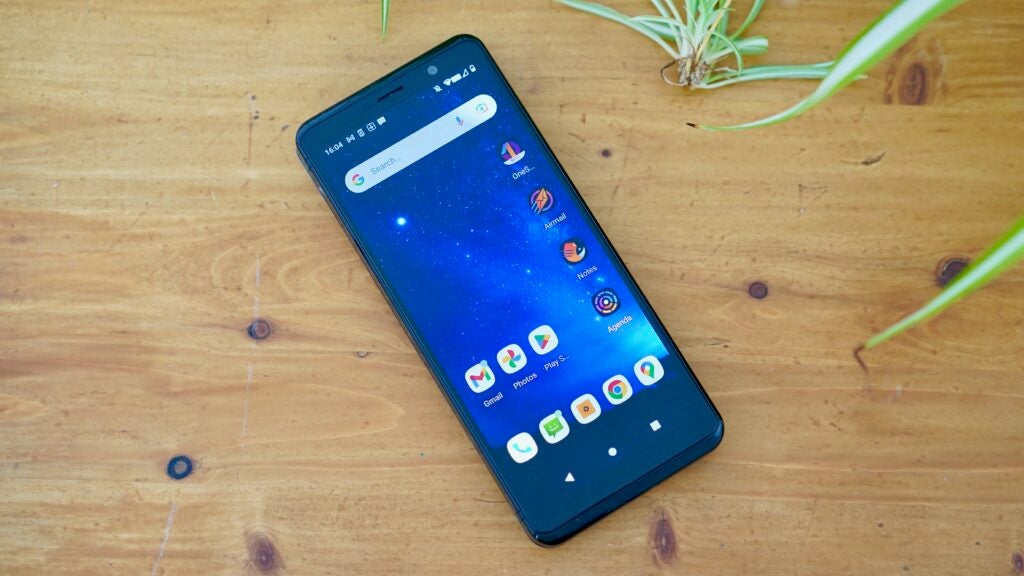
The Astro Slide looks as clunky as it feels. Its boxy plastic body, grooved rear cover, and retro camera module make it look like some kind of long lost prototype ‘compact’ film camera from the ‘80s.
The front of the phone looks a little more modern, but only so far as an early to mid-2010s Android phone. The phone’s full-sized AMOLED display is flanked by truly huge top and bottom bezels and exaggerated rounded corners.
We haven’t even discussed the main design talking point yet. The phone’s slide-out keyboard mechanism feels perilously janky and awkward right along its journey from beneath the display, with twin runners betraying oodles of flex and creak.
It’s all in service of the phone’s final and true form, however. Once that keyboard is locked into place, with the display resetting against the far edge and protruding at an obtuse angle, it suddenly all makes sense. At this point the reason for the weightier bottom half and those clumsy rubber feet come into focus, as you can now lay the phone on a flat surface and type with confidence.
This isn’t a full-sized qwerty keyboard, obviously, but it is a qwerty keyboard nonetheless. There’s a complete row of number keys along the top, an escape key in the top left, and a space bar on the bottom.
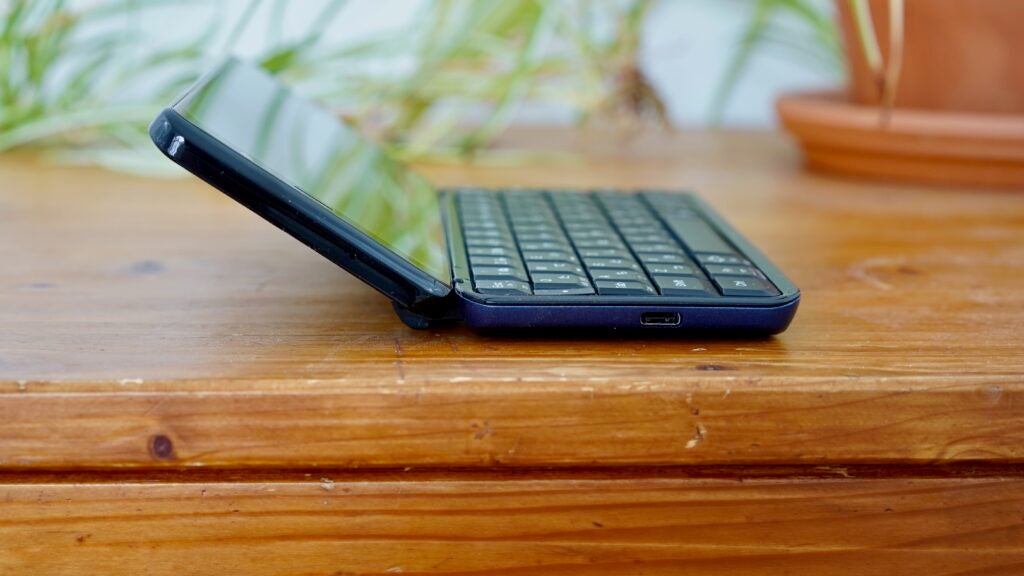
These are proper mechanical keys too, with a degree of travel that will be familiar to anyone who’s used a classic keyboard from before the MacBook chiclet era. They work reasonably well, with a satisfyingly springy thunk to every key press. With that said, you’ll need to press every key properly, as I found the odd missed keypress when attempting to type quickly.
If you’ve never fully adapted to digital keyboards, or you wish to compose long-form emails or notes as quickly and efficiently as possible, it presents a compellingly complete option. There’s simply nothing else out there right now that offers this kind of a ‘proper’ typing experience in anything approaching a smartphone form factor.
My model came with the Japanese kana keyboard printed out on the keys, but you can specify plenty of alternatives and can switch to 24 different layouts through the UI. This did provide issues for me when attempting to sort out my @s and ?s, however, which never quite seemed to correspond with what was indicated on the keys.
Away from the keyboard, Planet Computers has included two USB-C ports with the Astro Slide. This frees you up to charge from either side, and also enables you to hook up a peripheral whilst charging. You also get a 3.5mm headphone jack and stereo speakers, though the latter aren’t of great quality.
Nor, for that matter, is the Astro Slide’s 6.39-inch display. It’s plenty sharp enough at 2340 x 1080 (FHD+), and it’s an AMOLED panel rather than an LCD. But it’s the sort of AMOLED panel that reminds me of the early days of the technology, when Samsung used to crank the colours up to a crazy level of saturation.
Reds and oranges are ridiculously punchy here, and there’s no way to tune or adjust this colour profile in the Settings menu either. That’s become a fundamental feature of even most affordable AMOLED phones, and its absence here is badly missed.
You’ll also have to make do with a mere 60Hz refresh rate, which isn’t what we’re accustomed to seeing in an Android phone selling for more than £700.
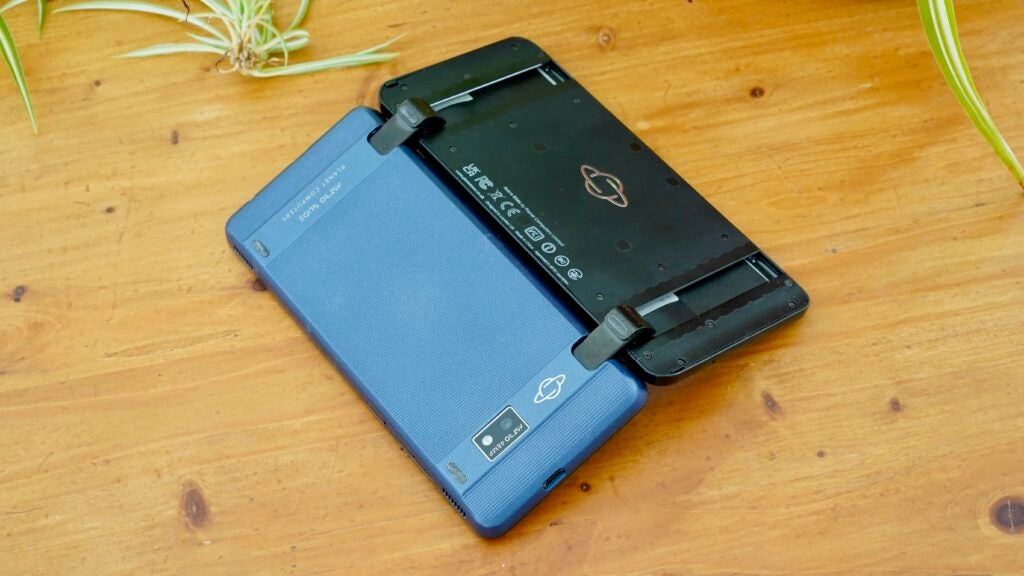
Camera
- 48MP main camera
- 13MP selfie camera
- General image quality falls below best mid-range phones
The Astro Slide’s camera system is brutally straightforward. There’s a single 48MP sensor on the rear, and a 13MP selfie camera on the front. Neither is good.
Several times when I took consecutive shots of the same thing, one would be hideously overexposed, while the other (invariably the second one) would be more balanced. This applied to both cameras.
Detail is fine on the main 48MP sensor, but you’ll need to manually select HDR mode. There’s no form of intelligent automation here. You might not want to toggle it on, however, as when I did all of my shots took on a weirdly grainy appearance, as if I was taking the shot through a finely textured window.
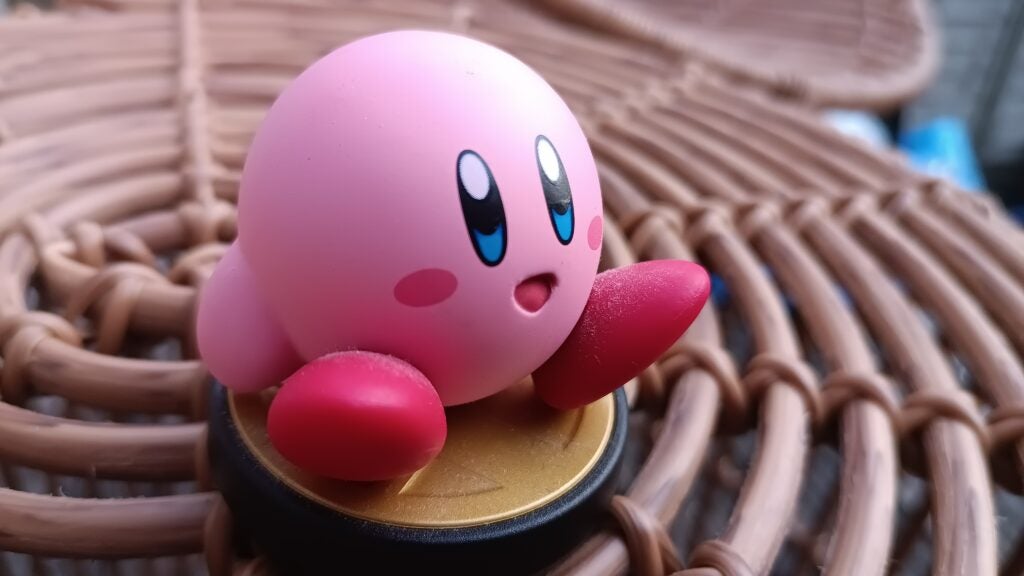
Night shots are rather grainy and murky, but not the worst I’ve encountered. It’s still the kind of result you’d expect to find in a cheaper phone rather than a £729 phone, however.
Selfie shots, meanwhile, are badly lacking in both detail and dynamic range, whether applying HDR or not.

Really, it’s best to view the Astro Slide’s camera offering as you would a tablet’s. Be glad that it’s there for emergency documentation, QR code scanning, and social media posts, but don’t rely on it for capturing any moments you actually want to retain for posterity.
Any decent mid-range phone, such as the OnePlus Nord 2T or the Google Pixel 6a, will run rings around it on the photographic front. But again, if you’re coming here for the camera, you’re rather missing the point.


Performance
- Low-end Dimensity 800 5G chip
- Modest, if consistent performance
- 128GB storage with microSD
The Dimensity 800 5G chip that powers the Astro Slide is not the kind of chip you tend to see in phones of this price. It’s the kind of chip that powers the Oppo Reno4 Z 5G, a phone that sold for less than half that amount back in 2020.
It’s paired with a decent 8GB of RAM, so app switching and general navigation isn’t an issue here. But for raw performance, the Astro Slide is far from the best Android phone. Average Geekbench 5 scores of 495 (single-core) and 2104 (multi-core) confirm that it’s very low down the Android smartphone pecking order.
GPU performance is a little better, with 3DMark results that beat phones running on the likes of the Snapdragon 695. Again, though, these tend to be much more affordable phones.
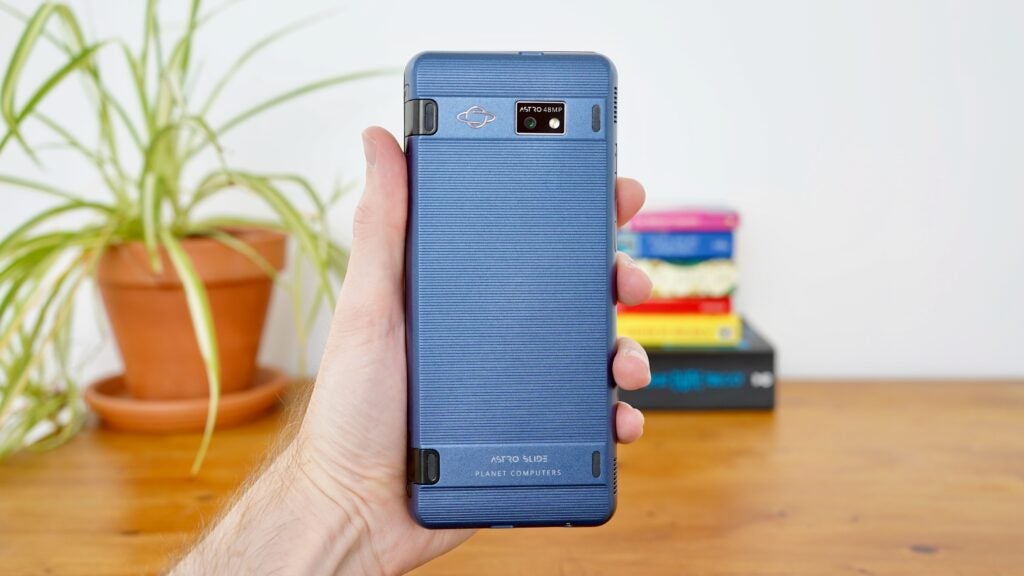
The focus, as ever, is firmly on that physical keyboard, which takes priority over any regular smartphone considerations. I highly doubt that any Astro Slide crowdfunder will be eagerly booting the phone up expecting or desiring a fluid game of Genshin Impact on high settings, and they won’t get one if they do.
Regardless of the Astro Slide’s very clearly and specifically defined audience, it’s a shame that we didn’t at least get a more modern and capable mid-range chip like the Dimensity 1200 or the Dimensity 1300. Although the device isn’t intended to run high-end tasks, it’s still a machine for enthusiasts of a sort, and a little more pop wouldn’t have gone amiss.
You do get a reasonably competitive amount of internal storage at 128GB, and there’s a microSD slot for expansion purposes too.
Battery Life
- Fairly small 4,000mAh battery
- Wireless charging supported
- 30W charger included
For such a hefty piece of kit, the Astro Slide sure does have a small battery. Bearing in mind again that this is comfortably the heaviest phone I’ve ever used, I had expected more than a 4000mAh cell.
In practice, likely thanks to that humble processor and modest 60Hz display, it’s up to the task. For the general typing-heavy tasks that the phone has been designed for, it should see you through a full working day with relative ease.
Heavier tasks will drain it quite quickly, but not disastrously so. Running the 3DMark Wild Life Stress Test three times over the space of an hour, the Astro Slide lost 18% of its charge. By contrast, a mid-range phone like the Realme 9 Pro Plus will lose around 13% in this scenario, while a more capable (and similarly priced) phone like the Xiaomi 12 might lose as much as 28%.
Planet Computers supplies a 30W charger in the box. That doesn’t make for the most flattering comparison a lot of ‘normal’ phones of this price, though it still beats the iPhone 14 and the Samsung Galaxy S22. As mentioned, there are two USB-C ports provided, meaning you can charge the Slide whilst simultaneously plugging in a USB device like an SD card reader, for example.
It also supports wireless charging, which I was pleasantly surprised to see included given the low-end specs elsewhere.
Latest deals
Should you buy it?
You want an honest-to-goodness physical qwerty keyboard on your phone: If you want a laptop-ish typing experience in the form (more or less) of an Android phone, this is the one for you, the Astro Slide is your only choice.
You expect a certain level of performance for your £730: It might cost £730, but most of that cost goes on the Astro Slide’s physical keyboard mechanism. Its performance is decidedly low end.
Final Thoughts
The Astro Slide is not a particularly good phone. It’s impractically big and heavy, its display is unbalanced, its performance is decidedly entry-level, and its camera falls behind a lot of phones selling for half the price. All this costs about as much as an iPhone 13.
Despite all of these downers, though, the Astro Slide is far from a write-off. In fact, it’s the best phone in its class. Sure, we’re talking about a class of one here, but then the Astro Slide’s niche appeal is kind of the whole point.
On its own highly specific terms, the Astro Slide is a success, albeit a qualified one.
How we test
We test every mobile phone we review thoroughly. We use industry standard tests to compare features properly and we use the phone as our main device over the review period. We’ll always tell you what we find and we never, ever, accept money to review a product.
Used as our main handset during test period
Camera tested in variety of situations with all modes
Tested with synthetic benchmarks and real world use
FAQs
No, this phone only has a 60Hz display – which is slightly disappointing for the price.
The standout feature of this phone is its sliding keyboard that lets you type out messages without using an on-screen keyboard.
Sustainability
Trusted Reviews holds the fact that global warming is not a myth as a core value and will continuously endeavor to help protect our planet from harm in its business practices.
As part of this mission, whenever we review a product we send the company a series of questions to help us gauge and make transparent the impact the device has on the environment.
You can see a detailed breakdown of the questions we ask and why in our sustainability info page. In lieu of answering each of these questions, Vivo has provided us with its company Sustainability Report.
Jargon buster
USB-C
The modern USB connector you’ll find on most Android phones, new laptops, cameras and games consoles. It’s reversible and used for charging along with data-transfer.
5G
Offering faster download and upload speeds when compared to 4G. Great for game streaming and HDR video playback. Not supported everywhere yet and speeds vary wildly.
OLED and AMOLED
Types of displays that use self-lighting pixels to provide greater contrast and more vibrant colours than a typical LCD display, as well as sharper blacks.
The Astro Slide is the very definition of a niche device, providing a uniquely accomplished full qwerty typing experience that you simply won’t find elsewhere. It’s lacking in almost every other way, however, and it isn’t as cheap as its components suggest, so only those who genuinely want that ‘pocket laptop’ experience need apply.
Pros
- Unique Qwerty typing
- Wireless charging
- Two USB-C ports
Cons
- Very big and heavy
- Screen very unbalanced
- Performance poor for the price
-
It’s differentA unique experience from a modern phone thanks to the keyboard -
StorageDecent amounts of internal storage -
Physical keyboardQWERTY Keyboard slides out from under the phone
Introduction
It might sound like a water park attraction, but the Astro Slide is actually a crowd-funded smartphone from Planet Computers, with much of the team behind the beloved Psion series working on its quirky PDA form factor.
For those unfamiliar with the wild pre-smartphone days, the key feature here is a full mechanical keyboard stashed behind a full-sized display. Crank that screen up and into position, and you effectively have a teeny tiny Android-powered laptop.
It’s something a lot of people used to pine for in the early smartphone days, and which a dedicated minority continue to desire – hence the Astro Slide’s crowdfunding success.
So does this jumble of old and new features cohere into a complete and satisfying device? Is it worth the £729 asking price? And who’s actually going to want to own such a phone? Let’s take a closer look.
Design and screen
- Thick and heavy body
- Somewhat creaky slider mechanism
- Unbalanced 60Hz AMOLED display
However you want to describe the look and feel of the Astro Slide, it ain’t subtle, and it sure as heck isn’t pretty. Even taking into account the phone’s unique slide-out keyboard, it’s a seriously chunky beast.
At 172.4 x 76.5 x 18.7mm when in its closed position, it dwarfs even the Samsung Galaxy Z Fold 4 in every direction. It’s way heavier, too, at 325g.
I’d go so far as to say that the Astro Slide’s size and weight makes it impractical to use as your primary everyday smartphone. Popping it into my shorts pocket while I did a few chores around the house, I was constantly aware of this huge weight at my side, and feared for the long term integrity of said pouch.

The Astro Slide looks as clunky as it feels. Its boxy plastic body, grooved rear cover, and retro camera module make it look like some kind of long lost prototype ‘compact’ film camera from the ‘80s.
The front of the phone looks a little more modern, but only so far as an early to mid-2010s Android phone. The phone’s full-sized AMOLED display is flanked by truly huge top and bottom bezels and exaggerated rounded corners.
We haven’t even discussed the main design talking point yet. The phone’s slide-out keyboard mechanism feels perilously janky and awkward right along its journey from beneath the display, with twin runners betraying oodles of flex and creak.
It’s all in service of the phone’s final and true form, however. Once that keyboard is locked into place, with the display resetting against the far edge and protruding at an obtuse angle, it suddenly all makes sense. At this point the reason for the weightier bottom half and those clumsy rubber feet come into focus, as you can now lay the phone on a flat surface and type with confidence.
This isn’t a full-sized qwerty keyboard, obviously, but it is a qwerty keyboard nonetheless. There’s a complete row of number keys along the top, an escape key in the top left, and a space bar on the bottom.

These are proper mechanical keys too, with a degree of travel that will be familiar to anyone who’s used a classic keyboard from before the MacBook chiclet era. They work reasonably well, with a satisfyingly springy thunk to every key press. With that said, you’ll need to press every key properly, as I found the odd missed keypress when attempting to type quickly.
If you’ve never fully adapted to digital keyboards, or you wish to compose long-form emails or notes as quickly and efficiently as possible, it presents a compellingly complete option. There’s simply nothing else out there right now that offers this kind of a ‘proper’ typing experience in anything approaching a smartphone form factor.
My model came with the Japanese kana keyboard printed out on the keys, but you can specify plenty of alternatives and can switch to 24 different layouts through the UI. This did provide issues for me when attempting to sort out my @s and ?s, however, which never quite seemed to correspond with what was indicated on the keys.
Away from the keyboard, Planet Computers has included two USB-C ports with the Astro Slide. This frees you up to charge from either side, and also enables you to hook up a peripheral whilst charging. You also get a 3.5mm headphone jack and stereo speakers, though the latter aren’t of great quality.
Nor, for that matter, is the Astro Slide’s 6.39-inch display. It’s plenty sharp enough at 2340 x 1080 (FHD+), and it’s an AMOLED panel rather than an LCD. But it’s the sort of AMOLED panel that reminds me of the early days of the technology, when Samsung used to crank the colours up to a crazy level of saturation.
Reds and oranges are ridiculously punchy here, and there’s no way to tune or adjust this colour profile in the Settings menu either. That’s become a fundamental feature of even most affordable AMOLED phones, and its absence here is badly missed.
You’ll also have to make do with a mere 60Hz refresh rate, which isn’t what we’re accustomed to seeing in an Android phone selling for more than £700.

Camera
- 48MP main camera
- 13MP selfie camera
- General image quality falls below best mid-range phones
The Astro Slide’s camera system is brutally straightforward. There’s a single 48MP sensor on the rear, and a 13MP selfie camera on the front. Neither is good.
Several times when I took consecutive shots of the same thing, one would be hideously overexposed, while the other (invariably the second one) would be more balanced. This applied to both cameras.
Detail is fine on the main 48MP sensor, but you’ll need to manually select HDR mode. There’s no form of intelligent automation here. You might not want to toggle it on, however, as when I did all of my shots took on a weirdly grainy appearance, as if I was taking the shot through a finely textured window.

Night shots are rather grainy and murky, but not the worst I’ve encountered. It’s still the kind of result you’d expect to find in a cheaper phone rather than a £729 phone, however.
Selfie shots, meanwhile, are badly lacking in both detail and dynamic range, whether applying HDR or not.

Really, it’s best to view the Astro Slide’s camera offering as you would a tablet’s. Be glad that it’s there for emergency documentation, QR code scanning, and social media posts, but don’t rely on it for capturing any moments you actually want to retain for posterity.
Any decent mid-range phone, such as the OnePlus Nord 2T or the Google Pixel 6a, will run rings around it on the photographic front. But again, if you’re coming here for the camera, you’re rather missing the point.


Performance
- Low-end Dimensity 800 5G chip
- Modest, if consistent performance
- 128GB storage with microSD
The Dimensity 800 5G chip that powers the Astro Slide is not the kind of chip you tend to see in phones of this price. It’s the kind of chip that powers the Oppo Reno4 Z 5G, a phone that sold for less than half that amount back in 2020.
It’s paired with a decent 8GB of RAM, so app switching and general navigation isn’t an issue here. But for raw performance, the Astro Slide is far from the best Android phone. Average Geekbench 5 scores of 495 (single-core) and 2104 (multi-core) confirm that it’s very low down the Android smartphone pecking order.
GPU performance is a little better, with 3DMark results that beat phones running on the likes of the Snapdragon 695. Again, though, these tend to be much more affordable phones.

The focus, as ever, is firmly on that physical keyboard, which takes priority over any regular smartphone considerations. I highly doubt that any Astro Slide crowdfunder will be eagerly booting the phone up expecting or desiring a fluid game of Genshin Impact on high settings, and they won’t get one if they do.
Regardless of the Astro Slide’s very clearly and specifically defined audience, it’s a shame that we didn’t at least get a more modern and capable mid-range chip like the Dimensity 1200 or the Dimensity 1300. Although the device isn’t intended to run high-end tasks, it’s still a machine for enthusiasts of a sort, and a little more pop wouldn’t have gone amiss.
You do get a reasonably competitive amount of internal storage at 128GB, and there’s a microSD slot for expansion purposes too.
Battery Life
- Fairly small 4,000mAh battery
- Wireless charging supported
- 30W charger included
For such a hefty piece of kit, the Astro Slide sure does have a small battery. Bearing in mind again that this is comfortably the heaviest phone I’ve ever used, I had expected more than a 4000mAh cell.
In practice, likely thanks to that humble processor and modest 60Hz display, it’s up to the task. For the general typing-heavy tasks that the phone has been designed for, it should see you through a full working day with relative ease.
Heavier tasks will drain it quite quickly, but not disastrously so. Running the 3DMark Wild Life Stress Test three times over the space of an hour, the Astro Slide lost 18% of its charge. By contrast, a mid-range phone like the Realme 9 Pro Plus will lose around 13% in this scenario, while a more capable (and similarly priced) phone like the Xiaomi 12 might lose as much as 28%.
Planet Computers supplies a 30W charger in the box. That doesn’t make for the most flattering comparison a lot of ‘normal’ phones of this price, though it still beats the iPhone 14 and the Samsung Galaxy S22. As mentioned, there are two USB-C ports provided, meaning you can charge the Slide whilst simultaneously plugging in a USB device like an SD card reader, for example.
It also supports wireless charging, which I was pleasantly surprised to see included given the low-end specs elsewhere.
Latest deals
Should you buy it?
You want an honest-to-goodness physical qwerty keyboard on your phone: If you want a laptop-ish typing experience in the form (more or less) of an Android phone, this is the one for you, the Astro Slide is your only choice.
You expect a certain level of performance for your £730: It might cost £730, but most of that cost goes on the Astro Slide’s physical keyboard mechanism. Its performance is decidedly low end.
Final Thoughts
The Astro Slide is not a particularly good phone. It’s impractically big and heavy, its display is unbalanced, its performance is decidedly entry-level, and its camera falls behind a lot of phones selling for half the price. All this costs about as much as an iPhone 13.
Despite all of these downers, though, the Astro Slide is far from a write-off. In fact, it’s the best phone in its class. Sure, we’re talking about a class of one here, but then the Astro Slide’s niche appeal is kind of the whole point.
On its own highly specific terms, the Astro Slide is a success, albeit a qualified one.
How we test
We test every mobile phone we review thoroughly. We use industry standard tests to compare features properly and we use the phone as our main device over the review period. We’ll always tell you what we find and we never, ever, accept money to review a product.
Used as our main handset during test period
Camera tested in variety of situations with all modes
Tested with synthetic benchmarks and real world use
FAQs
No, this phone only has a 60Hz display – which is slightly disappointing for the price.
The standout feature of this phone is its sliding keyboard that lets you type out messages without using an on-screen keyboard.
Sustainability
Trusted Reviews holds the fact that global warming is not a myth as a core value and will continuously endeavor to help protect our planet from harm in its business practices.
As part of this mission, whenever we review a product we send the company a series of questions to help us gauge and make transparent the impact the device has on the environment.
You can see a detailed breakdown of the questions we ask and why in our sustainability info page. In lieu of answering each of these questions, Vivo has provided us with its company Sustainability Report.
Jargon buster
USB-C
The modern USB connector you’ll find on most Android phones, new laptops, cameras and games consoles. It’s reversible and used for charging along with data-transfer.
5G
Offering faster download and upload speeds when compared to 4G. Great for game streaming and HDR video playback. Not supported everywhere yet and speeds vary wildly.
OLED and AMOLED
Types of displays that use self-lighting pixels to provide greater contrast and more vibrant colours than a typical LCD display, as well as sharper blacks.
























